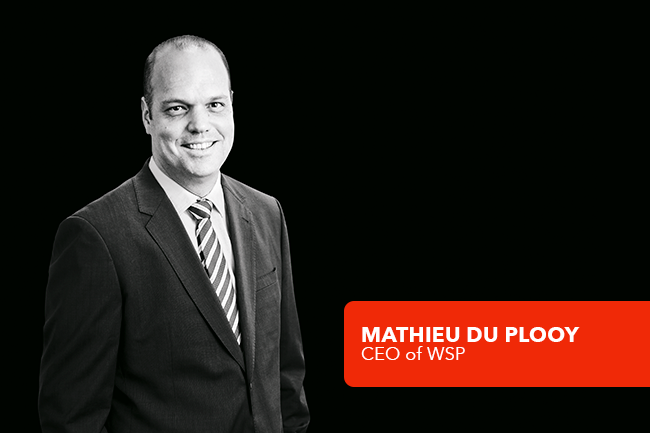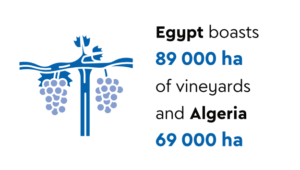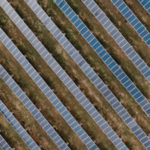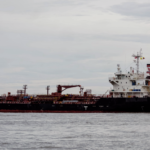It is widely accepted that engineering can offer solutions for an optimistic Africa that often fails to deliver on its infrastructure projects. Mathieu du Plooy, CEO of WSP, does not deny that the continent has its challenges. Indeed, he makes the point that businesses are struggling to align their services and operations with what drives individual country growth but overall, from this global engineering consultancy firm’s perspective, infrastructure development requires a seller-doer approach.
The seller-doer emphasis is one of the traits that have made WSP a leader in its field, and as such it has a strong and credible reputation as a solution provider.
‘Part of the reason for this is that not only do we have the expertise to understand a client’s needs, but we also provide the reassurance of a high level of accountability on the advice we provide from our professional network of engineers, scientists and designers. For me these are some of our differentiators, along with our versatility to provide a full spectrum of services, be those environmental or engineering,’ says Du Plooy.
These are crucial considerations for the private, quasi- or state-owned enterprises for which WSP provides services, including the humanitarian projects that it works on. Across the continent, WSP’s intellectual property and development expertise is what is valued most, and this has resulted in some 90% of the consultancy’s current business being driven by returning clients, or those who have been referred based on reputation and outcomes of successful projects.
Some of those international projects include the Shard in London and the Freedom Tower in New York but, as Du Plooy points out, each project WSP undertakes is seen as iconic. ‘Every project means something to the teams that work on them – they view them as “their” iconic project, and I acknow-ledge their pride because it applies equally to a power station in Zambia, a mine in Kenya or the upgrade of the Fourways Mall in Johannesburg. Our versatility is based on having strong local knowledge wherever we are, with the insight to deliver projects that are applicable to that specific environment, and future-proofing those to ensure growth. Having international expertise in specific sectors and being based in geographical regions allows us to be not just custodians of those areas but to outsource our abilities for use elsewhere.’
For example, WSP’s international marine and oceanology engineering arm is based in Stellenbosch, South Africa. It outsources its expertise to Canada, Asia and the UK. Similarly centres of excellence, based elsewhere in the world, can be tapped into for projects in Africa.
While delivery may still be considered one of the factors that hinder African development, largely because engineering projects are often thwarted by lack of political will or suitable funding given the perceived risks, Du Plooy argues that ensuring development has a positive conclusion lies largely in the hands of engineers and scientists. This is why WSP has an appreciation for the growth of engineering as a profession.
‘It’s a big part of WSP – to ensure that internal leadership development includes not only having technical skills but the ability to understand client needs, as well as being able to lead a team. This ensures our own leaders are more grounded,’ says Du Plooy.
WSP South Africa works with professionals from local African firms when needed. ‘In this way we can be assured not only that our own experts are working with local partners who have technical experience and expertise, but that the whole team is sensitive to any peculiarities of the environment.’
Engagement with its stakeholders is part of that development, especially when it comes to WSP’s design strengths. Innova-tions must be practical, not purely for the sake of being novel. Virtual reality, for example, is one of the latest adoptions by WSP. ‘It’s proving valuable in term of being able to show clients what a design looks like by increasing the visual information around the disciplines we specialise in,’ says Du Plooy.
While the continent struggles under a constrained economy, WSP is concentrating on two drivers of growth: consumerism and resources. The former presents opportunities for infrastructure development as people move from rural to urban environments, and the latter is the historic abundance of resources on the continent, and the growth of related industries such as oil and gas, energy and mining, most specifically in terms of logistics.
Du Plooy adds that another variation on the concept of ‘doing business in Africa’ is to look at specific sectors rather than countries. ‘You might find the economy in one nation is not performing as well as hoped. In that case it’s a matter of looking at industry-specific environments. For instance you might find us supporting a beverage client that is focused on expanding their facilities in more than one country. It’s really about building and focusing on a bridge of clients within a sector that works across the continent.’
The multiple-award winning WSP is most successful, however, because of its people. Du Plooy says that everyone is clear on the role they play and they take accountability – be that as an individual or as a whole. ‘Future positioning is how we see it – not just crucial for individual growth but for all our stakeholders.’

















